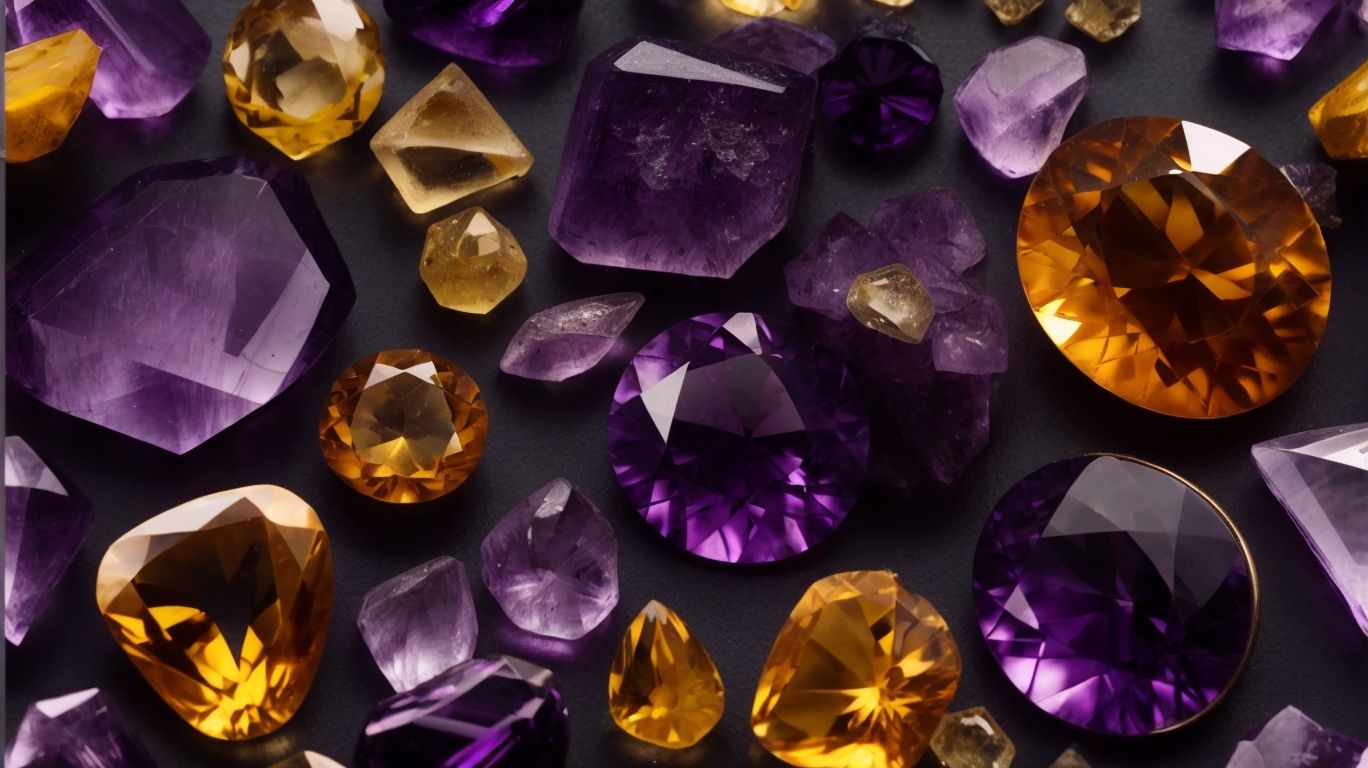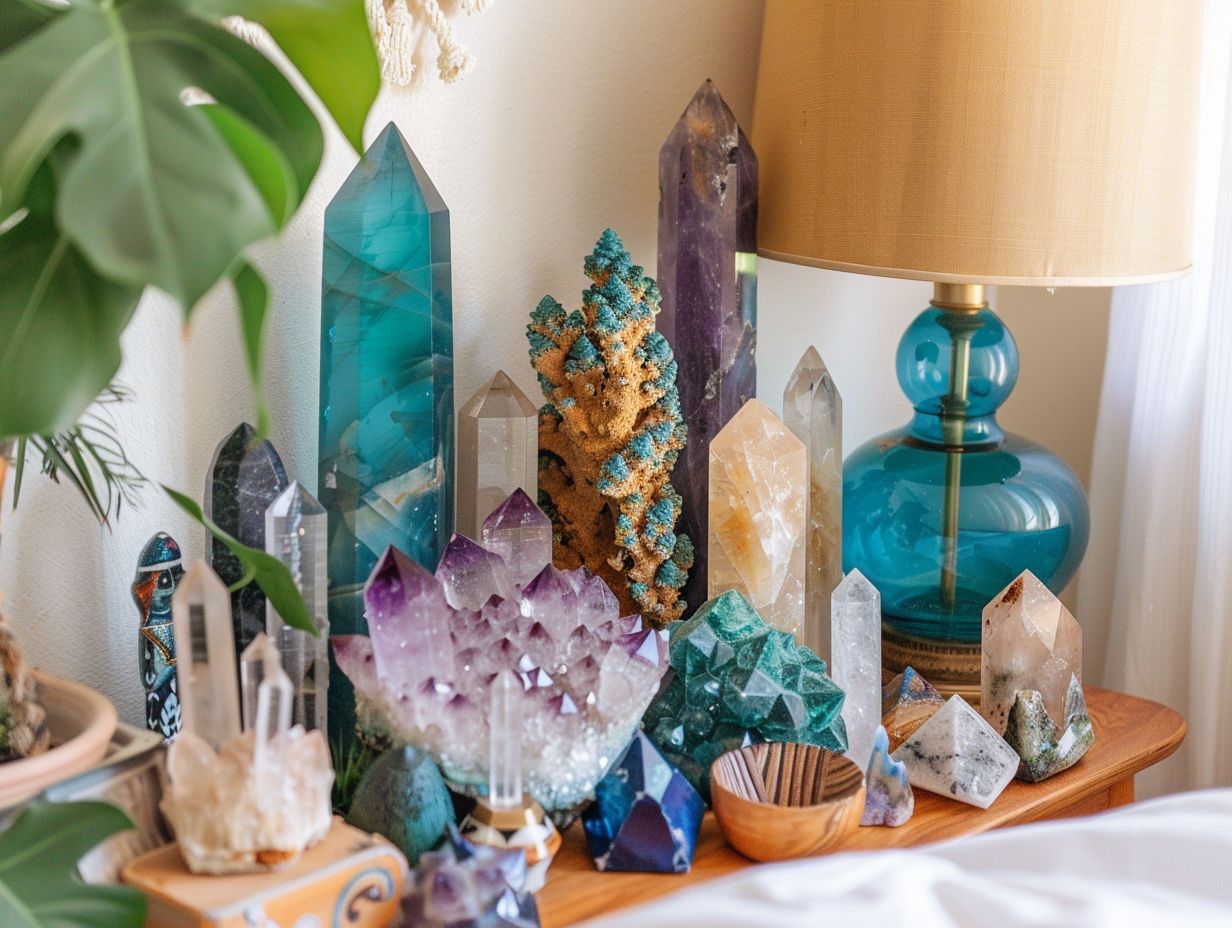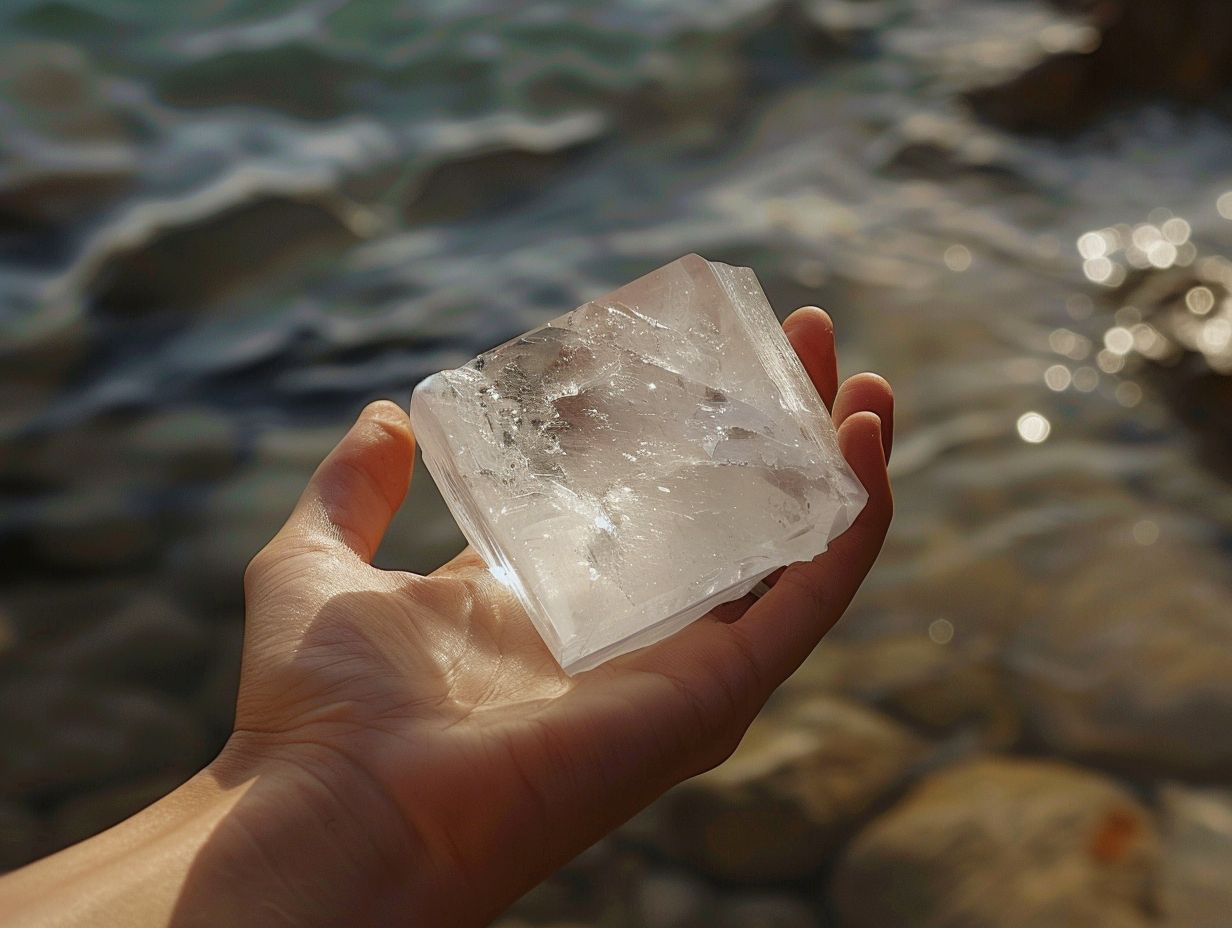
Amethyst vs. Citrine: Differences and Uses
Amethyst and citrine are two popular gemstones with unique characteristics and properties. In this article, we will explore the formation process of these gemstones and examine the physical differences between them, such as color, hardness, and clarity. We will delve into the metaphysical properties and healing uses of both amethyst and citrine. We will discuss how these gemstones are used in jewelry and compare their value and cost. We will explore the cultural and historical significance of amethyst and citrine, highlighting their similarities and differences. Join us on this fascinating journey to uncover the secrets of amethyst and citrine!
What Are Amethyst and Citrine?
Amethyst and Citrine are two distinct gemstones known for their unique colors, with Amethyst typically showcasing a rich purple hue and Citrine displaying a vibrant yellow shade.
Amethyst is often associated with qualities of peace, protection, and spirituality, making it a popular choice for those seeking to enhance their intuition and inner strength.
In contrast, Citrine is revered for its energy-boosting properties and its ability to promote positivity and prosperity.
The deep purple of Amethyst has long been linked to royalty and a sense of luxury, while the sunny yellow of Citrine symbolizes warmth and joy.
Both gemstones have been cherished throughout history for their beauty and believed metaphysical powers.
How Do Amethyst and Citrine Form?
Amethyst and Citrine have unique formations influenced by geological processes, with Amethyst typically forming in volcanic rock cavities and Citrine being a result of heat-treated Amethyst or formed in sedimentary environments.
- Amethyst, a variety of quartz, forms when silicon dioxide-rich solutions precipitate in cavities within igneous rocks such as granite or basalt. Over time, these solutions cool and crystalize, resulting in the vibrant purple hue characteristic of Amethyst.
- On the other hand, Citrine, a yellow variety of quartz, may be naturally occurring in sedimentary environments where it crystallizes due to the presence of iron impurities. Alternatively, Citrine can also be produced by heating Amethyst at high temperatures, causing its color to change to shades of yellow or orange.
What Are the Physical Differences Between Amethyst and Citrine?
Amethyst and Citrine exhibit physical variances in terms of color, hardness, and clarity, with Amethyst being known for its deep purple hues and Citrine for its sunny yellow tones.
In addition to their distinct color differences, Amethyst and Citrine also vary in terms of hardness and clarity. Amethyst, a type of quartz, typically has a hardness of 7 on the Mohs scale, making it a durable gemstone suitable for everyday wear. On the other hand, Citrine, also a variety of quartz, has a slightly lower hardness level, ranging from 7 to 7.5.
When it comes to clarity, Amethyst often showcases bands of color within the stone, adding to its mystique, while Citrine is praised for its transparent to translucent appearance, allowing light to pass through beautifully.
Color
The color differentiation between Amethyst and Citrine is one of the most prominent distinctions, with Amethyst typically displaying captivating shades of purple, while Citrine boasts sunny hues of yellow and golden tones.
These varying hues play a crucial role in gemstone identification, as the depth, intensity, and undertones of the colors can determine the quality and value of each stone.
Amethyst, for example, can range from pale lavender to deep violet, with prized specimens showcasing a rich, royal purple. On the other hand, Citrine can exhibit a range of shades from pale lemon-yellow to deep amber, with fiery golden tones also highly sought after by collectors and enthusiasts.
Hardness
In terms of hardness, Amethyst and Citrine exhibit variations due to their distinct mineral compositions and formation processes, with Amethyst typically having a Mohs hardness ranging from 7 to 7.5, while Citrine falls within a similar range depending on its structure and purity.
The Mohs scale of mineral hardness, devised by Friedrich Mohs in 1812, ranks minerals on a scale from 1 (softest) to 10 (hardest). Amethyst’s hardness is attributed to its composition primarily of silicon dioxide, giving it a durable nature suitable for jewelry.
On the other hand, Citrine, also a variety of quartz, may display varying hardness levels due to different impurities or growth conditions during its formation process, influencing its final hardness rating within the Quartz family.
Clarity
Clarity is another distinguishing feature between Amethyst and Citrine, with Amethyst often displaying varying levels of transparency and inclusions that add to its allure, while Citrine is known for its clear and transparent appearance with minimal inclusions.
Amethyst, due to its varying transparency levels, can range from almost opaque to semi-transparent, giving it a mystical depth that captivates many. Inclusions such as rutile needles or veils can create striking patterns within the gemstone, enhancing its unique beauty.
On the other hand, Citrine‘s remarkable clarity, often resembling the sunny hues of autumn, is prized for its pristine appearance without visible inclusions, making it a popular choice for jewelry that exudes elegance and sophistication.
What Are the Metaphysical Properties of Amethyst and Citrine?
Amethyst and Citrine hold significant metaphysical properties that are believed to influence energy flow, chakras alignment, and spiritual well-being, with Amethyst associated with clarity of mind and Citrine with abundance and joy.
Amethyst is often considered a powerful tool for opening and activating the Third Eye Chakra, enhancing intuition and psychic abilities.
On the other hand, Citrine is believed to resonate with the Solar Plexus Chakra, promoting self-confidence, creativity, and manifestation of one’s desires.
When used in combination, these two crystals can create a harmonious balance between spiritual insight and material abundance, facilitating a deeper connection to higher realms while grounding the energy to manifest positive transformations in one’s life.
Amethyst’s Properties
Amethyst is revered for its healing properties, making it a popular choice for meditation and spiritual practices, believed to enhance intuition, promote emotional healing, and provide protection against negative energies.
Many individuals find that when they incorporate amethyst into their meditation routines, the stone helps to create a sense of calm and tranquility, facilitating a deeper connection to their inner selves. In the spiritual realm, amethyst is often used to stimulate the third eye chakra, enhancing one’s spiritual awareness and promoting a clearer connection to the divine. This crystal is also known to aid in the development of intuition, allowing individuals to tap into their inner wisdom and trust their instincts more fully.
Citrine’s Properties
Citrine is known for its energizing properties that stimulate creativity, promote wealth, and attract prosperity, making it a favored choice for manifestation practices and enhancing one’s personal power.
Its vibrant yellow hue is believed to carry the power of the sun, infusing its wearer with a sense of joy and enthusiasm. By aligning with the solar plexus chakra, Citrine boosts self-confidence and encourages a positive outlook on life. This crystal is often used for energy cleansing, helping to rid the mind and space of negative energies while amplifying one’s ability to attract abundance and wealth. Those drawn to Citrine are often seeking to enhance their financial situation and overall prosperity.
What Are the Healing Uses of Amethyst and Citrine?
Amethyst and Citrine are valued for their healing properties, with Amethyst often used for energy cleansing, emotional healing, and clarity of mind, whereas Citrine is employed for boosting energy flow, promoting emotional balance, and fostering personal growth.
These gemstones have been treasured for centuries for their ability to soothe the mind, body, and spirit, aiding in meditation and mindfulness practices.
Amethyst’s calming energy is known to help alleviate stress and anxiety, allowing for a deeper sense of peace and tranquility.
On the other hand, Citrine’s vibrant energy is believed to enhance creativity, increase motivation, and attract abundance into one’s life, making it a popular choice for those seeking positive transformation and manifestation.
When used together, Amethyst and Citrine create a powerful synergy that uplifts and harmonizes one’s energetic field, promoting overall well-being and personal development.
Amethyst’s Healing Uses
Amethyst’s healing properties are often harnessed for enhancing mental clarity, deepening meditation practices, and balancing chakras to promote spiritual well-being and emotional stability.
This vibrant purple gemstone is known for its ability to quiet a busy mind and ease anxiety, allowing one to connect with their inner thoughts and emotions.
In meditation, Amethyst serves as a powerful tool to create a tranquil space and access higher states of consciousness. Its energy helps align the crown chakra, fostering a sense of spiritual balance and raising awareness of one’s higher self.
Whether worn as jewelry, placed in your living space, or incorporated into healing rituals, Amethyst can be a valuable companion on your journey to inner peace and self-discovery.
Citrine’s Healing Uses
Citrine’s healing properties are associated with fostering joy, attracting wealth, and boosting self-confidence, making it a sought-after crystal for invoking positivity, abundance, and personal empowerment.
Known as the ‘merchant’s stone,’ Citrine is believed to hold the power to not only attract financial prosperity but also to foster a sense of joy and enthusiasm in one’s life. This vibrant yellow crystal is often linked to the solar plexus chakra, promoting feelings of empowerment and self-assurance. By radiating a warm energy that uplifts and energizes, Citrine is said to help in overcoming self-doubt and encouraging a positive mindset. Its sunny disposition can brighten even the darkest of days, bringing a sense of wellbeing and optimism to those who embrace its energies.
How Can Amethyst and Citrine Be Used in Jewelry?
Amethyst and Citrine are popular choices for jewelry crafting, with Amethyst often featured in intricate designs for crystal grids and spiritual adornments, while Citrine finds its place in elegant pieces symbolizing abundance and positivity.
These gemstones are not only prized for their aesthetic appeal but also for their metaphysical properties. Amethyst is known for its ability to enhance intuition and promote a sense of calm and balance, making it a favored choice for creating talismans and amulets to ward off negative energy.
On the other hand, Citrine is associated with prosperity and success, making it a sought-after stone for jewelry pieces aimed at attracting wealth and good fortune. When combined in jewelry making, Amethyst and Citrine can create beautiful and meaningful pieces that not only adorn the body but also uplift the spirit.
Amethyst Jewelry
Amethyst jewelry is cherished for its ability to foster spiritual connections, provide protection against negative energies, and enhance intuitive abilities, making it a meaningful accessory for those seeking inner clarity and emotional balance.
This stunning purple gemstone is not just a beautiful adornment but also a powerful tool for those looking to tap into their spiritual side. Amethyst is believed to have a calming effect on the mind, helping individuals find peace and tranquility amidst life’s chaos. Its protective qualities act as a shield against negative energies, creating a sense of safety and security. Wearing amethyst jewelry is thought to amplify one’s intuition, allowing for better decision-making and a deeper connection to the inner self.
Citrine Jewelry
Citrine jewelry is often associated with attracting prosperity, fostering wealth accumulation, and aiding in manifestation practices, serving as a symbol of abundance, success, and positive energy flow.
This beautiful gemstone is believed to carry the energy of the sun, radiating warmth and light into one’s life. Citrine is thought to clear the mind of negative thoughts and enhance one’s creativity and imagination, making it a popular choice for those seeking to align with their goals and desires. By wearing citrine jewelry, individuals aim to invite opportunities for financial success and to amplify their intentions for a prosperous and fulfilling life.”
How Are Amethyst and Citrine Different in Terms of Value and Cost?
Amethyst and Citrine differ in their market values and costs, with Amethyst generally commanding higher prices due to its rarity and historical significance, while Citrine is more affordable and widely available in various jewelry pieces.
Factors that influence the pricing of gemstones such as Amethyst and Citrine include characteristics like color, clarity, cut, and carat weight.
Amethyst’s deep purple hues and association with luxury contribute to its higher value compared to the softer, yellow hues of Citrine.
The mining locations play a crucial role, as Amethyst is found in fewer regions globally, rendering it more scarce and exclusive. On the other hand, Citrine is often heat-treated Amethyst or sourced from more accessible deposits, leading to its lower cost and increased availability in the market.
What Are the Similarities and Differences in the Cultural and Historical Significance of Amethyst and Citrine?
Amethyst and Citrine share both cultural and historical significance, with Amethyst often associated with spiritual growth, clarity, and protection in various mythologies and folklore, while Citrine is linked to abundance, prosperity, and optimism in different cultural narratives.
Amethyst, historically valued for its royal purple hue, has been revered for centuries as a talisman of wisdom and strength. Its deep connection to spirituality and the divine is reflected in ancient civilizations’ beliefs that wearing amethyst can help connect one with higher realms.
Citrine, known for its vibrant yellow to orange tones, has symbolized energy, creativity, and success, serving as a beacon of light and warmth in cultural stories and traditions. Both gemstones hold a revered place in human history, bridging the earthly and spiritual realms with their unique energies.
Amethyst’s Cultural and Historical Significance
Amethyst holds deep cultural and historical significance, symbolizing spiritual connections, protective energies, and transformative properties in various ancient beliefs and mythological tales.
Throughout history, Amethyst has been associated with the divine realms, believed to enhance one’s spiritual awareness and intuition. In many cultures, it is revered as a stone that wards off negative energies and provides a sense of inner peace and balance. Ancient myths often depict Amethyst as a symbol of transformation, representing the journey of personal growth and evolution. Its violet hues have been linked to the Crown Chakra, aligning with higher consciousness and spiritual expansion, making it a cherished gemstone for those seeking clarity and enlightenment.
Citrine’s Cultural and Historical Significance
Citrine carries rich cultural and historical symbolism, representing abundance, joy, and wealth in various mythological traditions and cultural beliefs, often associated with positivity, success, and optimistic outlooks.
Throughout history, Citrine has been revered for its ability to attract prosperity and good fortune. In Greek mythology, it was linked to the sun god, bringing warmth and light into people’s lives. In Chinese culture, Citrine symbolizes wealth and success, often placed in businesses to enhance financial luck. The sunny hue of Citrine has also been associated with happiness and energy, making it a popular choice for jewelry and talismans believed to uplift spirits and attract positivity.




No Comments